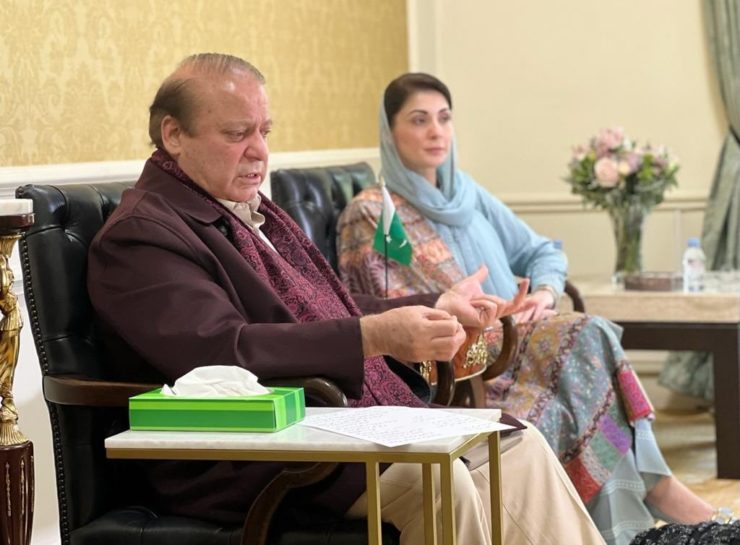
South Asia’s political stage is perhaps one of the most interesting in the world, characterised by struggling democracies, a heavy and unstable mix of religion and politics, and the presence of political dynasties. As Nawaz Sharif returns to Pakistan after years of exile in the United Kingdom amidst controversy after controversy, it is perhaps worthwhile to take a look at the different political dynasties in South Asia and their dynamics in their countries.
Pakistan is probably the polity with the largest number of significant and powerful political dynasties. Two of the major parties – the PML-N and the PPP – have at their center and leadership these dynasties, namely the Sharifs and the Bhuttos. Though family lineages and connections characterise the clientelistic nature of Pakistan’s electoral and social politics, it is primarily these two that have managed to attain and maintain statewide power, though in differing degrees.
Though the Bhuttos are a slightly older legacy dating to Zulfiqar Ali Bhutto, the Sharifs hold huge political sway, partly due to their center of power in the Punjab, the most populous and developed province in the country, owing to a long history of preferential treatment.
Today, the Sharifs have managed to consolidate power through the presence of numerous family members in politics, including Nawaz Sharif, his children and his brother Shahbaz Sharif, the last Prime Minister prior to the arrival of the caretaker government in 2023. The Sharifs are also major industrialists, owning a wide range of businesses across different sectors.
The Bhuttos and the PPP, nevertheless, remain the most powerful dynasty in Sindh, and the current patriarch Asif Ali Zardari is widely considered today’s Kingmaker; i.e. any political coalition requires his participation in order to succeed due to the support of he and the PPP are able to control.
The Bhuttos are also represented by his son Bilawal Bhutto, the son of Zardari and Benazir Bhutto, the first female Prime Minister of the country and a beloved figure amidst her supporters.
The Bhuttos’ importance is perhaps reflected more in their participation in political coalitions rather than independent power. Though the PPP was the first party in Pakistan’s history to complete a democratic term without interruption from 2008-2013, it now lacks the elctoral base on its own to be able to control the state. As such, hence Zardari and his son’s position as the Kingmakers. Their support is critical to turning political tides, as demonstrated by the coalition formed between them, the Sharifs and others in the PDM that managed to overthrow Imran Khan’s PTI government.
Sri Lanka is another South Asian country that has an extremely powerful political dynasty. The Rajapaksa family, represented most significantly by the brothers Mahinda and Gotabaya Rajapaksa, came to power during the final phases of the Sri Lankan Civil War in the 2000s. Both brothers have held the post of President and Prime Minister since then, and also other significant posts, such as in the Ministry of Defence.
Gotabaya Rajapaksa is most well-known for his position as Permanent Secretary in this last department in 2005, and is a controversial figure due to the purported atrocities the Sri Lankan army conducted in its war against the Tamil Tigers (LTTE) in the final phase that was overseen by him. More recently, Gotabaya served as the President of Sri Lanka from 2019 till 2022, where he resigned due to public outrage over Sri Lanka’s economic turmoil, amid much publicised riots that saw mobs storm the Presidential residence only to find it deserted.
India is a country where political dynasties have declined in importance over time, though not as significantly as may seem. The one major dynasty are the descendants of Jawaharlal Nehru, the first and longest-serving Prime Minister of India. Succeeded by his daughter Indira Gandhi – the second-longest serving PM -, the Gandhis have been major leading figures and the face of the Congress Party in India.
Indira Gandhi was assassinated in October 1984 by her own Sikh bodyguards as a reprisal for the military action Operation Blue Star against Sikh separatists that had killed several of them in the Golden Temple in June of that year. Anti-Sikh riots in the days following her assassination claimed over 8000 lives, overwhelmingly Sikh.
She was succeeded by her son Rajiv Gandhi, who was forced to resign in 1989 amid corruption scandals involving an arms-deal with Sweden that tarnished his image, before he himself was assassinated in 1991 by the LTTE for supporting the Sri Lankan Army during a phase of the Civil War in Sri Lanka.
The heir to the legacy of the Gandhis today is Rahul Gandhi, who styles himself and the Indian Congress as the only hope for restoring democracy in India in the face of the Bharatiya Janata Party’s rise and consolidation of power. Rahul Gandhi has taken steps to reverse the image of the Gandhis and the Congress at large as elitist and disconnected from the masses, such as his countrywide march on foot this year to drum up support for the Congress in next year’s elections. Though he is no longer the party’s President (since 2019), Rahul Gandhi in many ways remains the face of the Congress and its alliance.
Political dynasties in South Asia thus seem to enjoy a longevity and prominence that is not common in most other regions. Though the above examples are more detailed, they are not the only ones present in the region, Bangladesh also has its own. The lack of development of democracy indigenously and general lack of political education is perhaps one reason for this, many believe that polities such as the ones in Pakistan and India are far more likely to vote on the basis of personalistic politics rather than policy, which can help explain the appeal of political dynasties as elements of continuity and familiarity.
Taut Bataut – is a researcher and writer that publishes on South Asian geopolitics, exclusively for the online magazine “New Eastern Outlook”.
